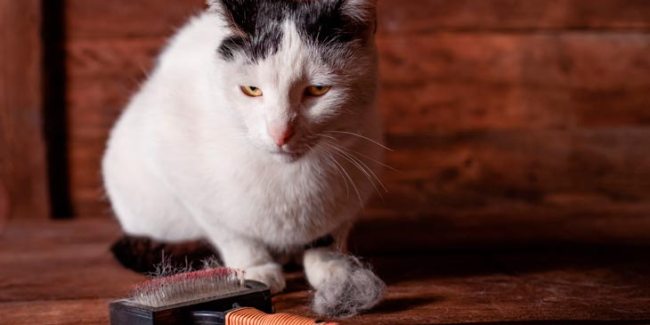Dog Hair Loss – The Naked Truth
If your dog’s hair is falling out more than just normal shedding or you see some spots on the body where skin is visible, it’s likely your dog has any of a number of conditions that fall under the general name “alopecia,” which simply means “balding.” While human hair loss remains mainly a male issue, hair loss in canines affects both male or female dogs and is usually a sign that there is an underlying problem. There are a number of reasons why your dog could be losing his or her hair so it is advisable to seek veterinary advice to investigate the possible underlying causes and develop a treatment plan.
DOG HEALTH

Posted by bravectosouthafrica – 05 February 2021
Dog Genetics
The cause of your dog’s hair loss may be related to genetic make-up. Hair loss can result from a lack of normal development of the hair follicles when your dog is a puppy and his or her coat fails to grow in fully. Or, your pooch may have been born with a normal coat and when he or she becomes a young adult, patchy or widespread hair loss develops.
Sometimes, it is normal for dogs to develop bald patches as they get older. Greyhounds, Whippets, Chihuahuas, Dachshunds and Italian Greyhounds are especially susceptible to losing hair on the outer ear, chest, belly, thighs or lower neck as they get older.
Nutrition
A diet that is not well-balanced can also have an impact on your dog’s coat. Commercial dog foods will almost always provide the nutritional balance your dog needs to prevent this problem, but if you home cook your dog’s meals, you need to ensure the meals contain the right nutrients and in the right proportions to aid your dog’s health and wellness.
Hormones
Pregnant and nursing dogs sometimes experience temporary hair loss due to hormonal changes. The hair loss usually stops when the hormones return to normal levels, after the period of pregnancy and nursing is over.
One common cause of hair coat changes in dogs is Hypothyroidism, usually a result of an under-active thyroid. In this condition, decreased levels of thyroid hormones result in a slower metabolic rate. Most cases of hypothyroidism in dogs are caused by apparent auto-immune destruction of the thyroid gland itself. Another potential cause is a tumour on the pituitary gland at the base of the brain, which can lead to deficiencies of other hormones as well.
Dogs with hypothyroidism generally exhibit signs such as dry skin and excessive shedding with delayed regrowth of hair. They may also have loss of or thinning hair in the same pattern on both sides of the body. Blood tests may be needed to confirm the diagnosis.
Cushing’s Disease is another common cause of hair loss in dogs. With this condition, related to the function of the adrenal gland cortex, your dog’s body makes too much of the hormone “cortisol”. This leads to a weakened immune system and other changes that potentially leave the dog vulnerable to other diseases and infections. This slow-developing disease usually occurs in middle-aged to older dogs. Early signs are not always noticed but the clinical signs can include increased drinking and urinating, fragile or thin skin, hair loss and recurrent skin infections.
Fleas
Fleas are a real stress for pets as their bites are itchy, causing your dog to be restless, biting at their skin, scratching and licking incessantly. Some dogs are also very allergic to flea saliva and can develop a severe reaction to bites. Signs of flea allergy in dogs include reddened, flakey, itchy skin on the hips, base of the tail and thighs. This often leads to hair loss, scabbing and secondary infections. As the condition becomes chronic, hair loss as well as thickened and darkening skin are seen.
Mange
Mites cause mange – a skin disease that occurs when your dog’s skin becomes infested with one of several different species of these pests that embed themselves either in or on your dog’s skin or in the hair follicles. The mites can cause irritation of the skin, resulting in itching, hair loss or inflammation. While dog mange is usually treatable, some forms are highly contagious and can cause dangerous complications.
Canine Scabies is highly infectious and caused by a specific mite called Sarcoptes scabiei var canis. This itchy little parasite causes intense itching with small, solid bumps infesting the skin. As your dog scratches or bites to relieve the itch, these bumps and surrounding skin can become damaged, causing thick, crusted and even infected sores. These mites can bite people too.
Ear Mites is another form of mange caused by mites known as Otodectes cynotis, which infest the external ear canal. These mites cause inflammation of the lining of this ear canal but are also sometimes found on the body as well. This condition can be very distressing to dogs who scatch inside their ears constantly causing additional damage.
Walking Dandruff (Cheyletiellosis) caused by the Cheyletiella yasguri mites, this condition commonly causes intense itching and scaling of the skin along the back.
Canine Demodicosis (Demodex canis) mites are often found in small numbers in the hair follicles of all dogs and are perfectly normal, causing no sign of disease. Occasionally dogs become infested with large numbers of these mites, resulting in hair loss and inflammation. Veterinarians are not really sure why this happens in certain dogs but there is some evidence of hereditary predisposition for the condition, causing a weakened immune system response to the mites.
Trombiculosis type of mite looks like tiny spiders and can be seen on your pet as tiny, orange-red dots. They frequently cluster on the head, ears, feet or belly. Infestation can cause an allergic reaction which presents as redness, bumps, hair loss and crusty skin. Intense itching can be associated with this problem which is often reported in autumn and sometimes called harvest mites.
Allergies
Dogs also suffer from common allergies like humans which come from everyday substances in their environment such as pollen or mould, or specific ingredients in food. These allergy-inducing substances are called allergens.
Allergies are not breed-specific and usually present between 6 months to 3 years old. Allergies are also not always season-specific and can occur throughout the year. Signs of allergy include intense itching around the feet, face, ears, front legs and abdomen. Scratching can lead to secondary issues such as scabbing, skin and ear infections, hair loss and scaly skin. Your dog can also become depressed due to the constant physical symptoms.
Skin Infections
Another ailment that people and dogs share is bacterial or fungal infections on the skin that can result in irritation that can cause hair loss.
Pyoderma infections can occur when bacteria enter broken skin as a result of scratching or from flea bites. Sometimes the skin is red and has local collections of pus under the skin similar to that of pimples seen on humans’ skin.
Yeast Infections/ Malassezia infections can occur when normal yeast levels on dogs’ skin becomes overgrown. These infections can cause skin irritation and sores as well as hair loss.
Ringworm also known as “tinea,” ringworm is not caused by an actual worm, but a fungal infection of the hair and hair shafts that gets its name from the round patches of flaky skin and broken hairs that result. Pets can easily-pass ringworm onto humans too.
Remember…
This is not a complete list and there are other possible causes of hair loss to consider most of which are easily treated.
Treatment for Dog Hair Loss
The first step in addressing any concern about hair loss is to take your dog to the veterinarian so that an accurate diagnosis can be identified. This will require a detailed history of your pet and a physical examination. Notable points in your dog’s history could include breed and tendencies for congenital or hereditary hair loss, as well as information from you concerning the details of the problem and if your dog has been itching and scratching or not. Your veterinarian will check your pooch’s general health and look for evidence of infection.
The veterinarian will often also examine a hair sample from your pet under a microscope to determine if the hairs are being shed from the follicle, or if they are being broken off. Your veterinarian may also perform a skin scrape to look for parasites or infections and/or comb the coat for fleas, mites and lice. The skin scrapings and materials from the combing may be sent to a laboratory for further analysis. Occasionally a referral to a specialist in veterinary dermatology may be needed to reach a final diagnosis in more complex cases.
Successful treatment of your dog’s hair loss depends on correctly identifying the underlying cause of the problem. Treatment could include medications, antibiotics, creams, shampoos (for example Pyostat) or prophylactic regimens such as flea and tick preventatives such as Bravecto®.
If you see any indication of hair loss in your beloved pooch, it’s a good idea to seek the advice of your veterinarian to rule out potentially serious causes that may become worse if not effectively addressed. They will recommend the best course of dog hair loss treatment.
Subscribe to our Newsletter
Get to know your furry friend better! Sign up for all things dog- or cat-related.
The Hairy Facts about the dreaded hairball
12 April 2021
Help! My dog’s barking mad! Volume 2
12 April 2021
Your Itchy, Scratchy Cat – All About Cat Skin Problems
12 April 2021
The Dog’s Diet: A Bone of contention?
01 April 2021
Mango Fly Worms: How to Spot and Eliminate them
Posted on November 28,2019
Managing Mange And Mites In Your Dog
Posted on June 11,2018
Why Do Cats Purr and How? Learn What Your Cat Is Saying
Posted on October 14,2020
How to Get Rid of Ear Mites in Dogs
Posted on November 06,2019









